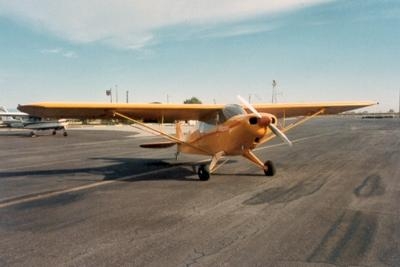Pilot Fatally Injured When The Plane Went Down Just After Takeoff On First Flight After Restoration
The NTSB has released its preliminary report from an accident which occurred on April 8 at about 1256 EDT. A Piper PA-12 Super Cruiser was destroyed by impact and a postcrash fire after takeoff from Orlando Sanford International Airport (SFB), Orlando, Florida. The airline transport pilot flying the plane was fatally injured. VFR conditions prevailed and no flight plan was filed for the local personal flight.

According to review of preliminary air traffic control communications, the pilot received a takeoff clearance for runway 27L to remain in the airport traffic pattern, which he acknowledged. There were no further communications with the pilot. A witness to the accident recorded the flight on his cellular telephone. He provided the video, and gave a statement to airport police, which was consistent with the content of the video. According to the witness, the "airplane accelerated normally for takeoff, pitched up, and continued to pitch up into a full stall, rolled to the right and nosed in on right side of 27L." He stated a postimpact fire ensued and was extinguished by aircraft rescue and firefighting personnel.
The pilot held an airline transport pilot certificate with an airplane single and multiengine land ratings. He also held a flight instructor certificate with ratings for airplane single and multiengine and instrument airplane. His most recent FAA first-class medical certificate was issued on February 7, 2017, with the limitation, "must wear corrective lenses. " The pilot reported 25,000 total hours of flight experience on that date.
The three-seat, high-wing, tail-wheeled, fabric-covered airplane was manufactured in 1947. It was powered by a Lycoming O-235-C1C engine, rated at 115 horsepower, that was equipped with a Sensenich two-bladed, fixed pitch propeller. The accident flight was the first flight following a 2-year restoration of the airplane that included replacement of the wing and fuselage fabric, flight control cables, and electrical wiring.
The airplane came to rest inverted, oriented on magnetic heading of about 170°, in the grass about 9 ft north of runway 27L, adjacent to the 1,000 ft markers. The nose of the airplane was crushed aft. The propeller was attached to the engine, which was located adjacent to a linear ground crater.
The empennage, fuselage, cockpit, and wings were consumed by postimpact fire. The engine exhibited significant thermal damage, and several of its accessories were separated. The engine crankshaft was rotated by hand and continuity of the valve train was established from the crankshaft flange to the rear gears. Thumb compression was obtained on all four cylinders.
All flight control surfaces (ailerons, flaps, rudder, elevators, and trimmable horizontal stabilizer) were attached to their respective attach points. The left and right aileron cables were continuous from the control stick to their respective bell cranks. The rudder cables were continuous from the foot pedals to the rudder bell crank.
The elevator control cables were found attached to the upper and lower ends of the elevator control horn in the tail of the airplane. Elevator control cable continuity was established from the control horn to the forward and rear control sticks.
Manipulation of the elevator control cables revealed that a nose-up control stick input resulted in a nose-down deflection of the elevator and vice versa. Further examination revealed that the elevator control cables were improperly rigged, such that they were attached to the incorrect (opposite) locations on the upper and lower elevator control horn.
(Source: NTSB. Image from file)
 TikToker Arrested After Landing His C182 in Antarctica
TikToker Arrested After Landing His C182 in Antarctica Classic Aero-TV: Versatile AND Practical - The All-Seeing Aeroprakt A-22 LSA
Classic Aero-TV: Versatile AND Practical - The All-Seeing Aeroprakt A-22 LSA ANN's Daily Aero-Term (06.27.25): Hazardous Weather Information
ANN's Daily Aero-Term (06.27.25): Hazardous Weather Information ANN's Daily Aero-Linx (06.27.25)
ANN's Daily Aero-Linx (06.27.25) Aero-News: Quote of the Day (06.27.25)
Aero-News: Quote of the Day (06.27.25)



